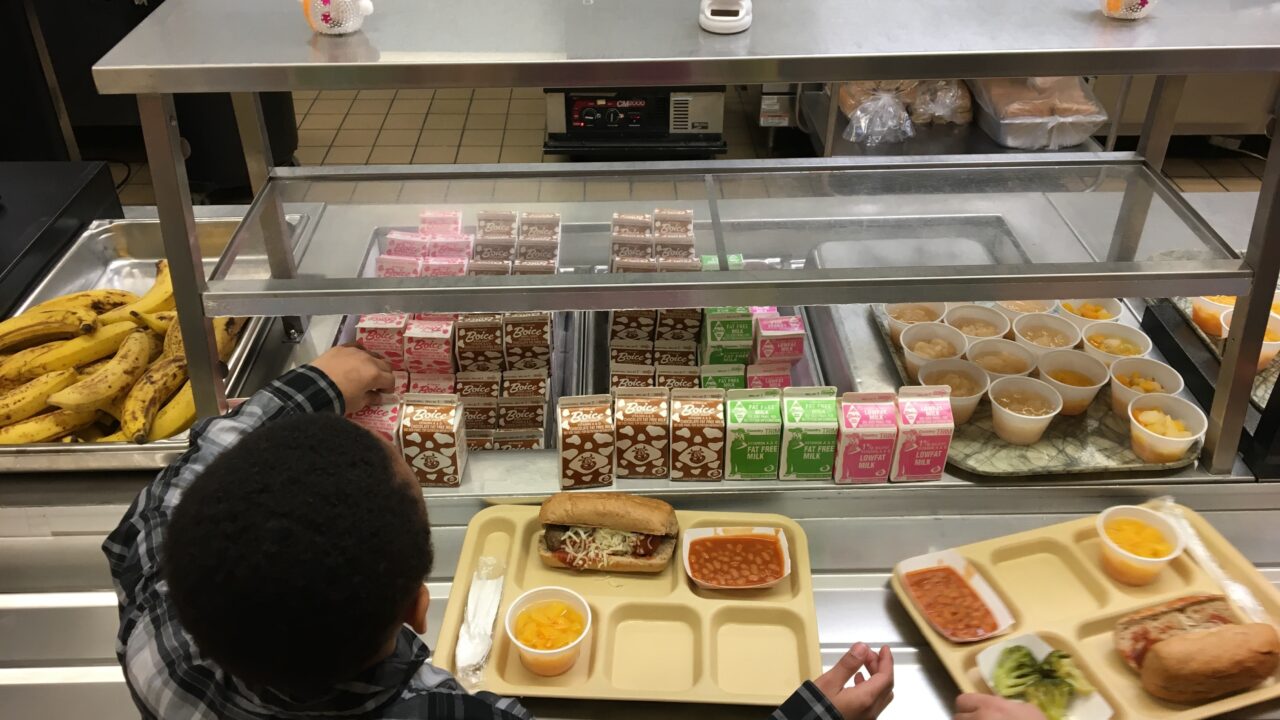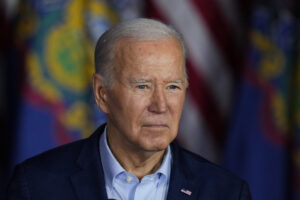Students Are Struggling with School Lunch Debt
Students across the U.S. are burdened with more than $19 million in unpaid school lunch debt. Students fill their lunch trays at J.F.K Elementary School in Kingston, N.Y. Photo: Mary Esch / AP.
Students fill their lunch trays at J.F.K Elementary School in Kingston, N.Y. Photo: Mary Esch / AP.
Students from low-income families across the country are accruing school lunch debt in record numbers. Federal data shows that participation in school lunch programs dropped by 23% after pandemic-era free lunch programs ended. A recent survey by the School Nutrition Association found that students across the country are burdened with more than $19 million in school lunch debt.
In 2020, Congress made the historic decision to feed students at no cost through the federal lunch waiver program. Child food insecurity decreased by 7% between 2020 and 2021, and more than 50.6 million public school students were fed nationwide. But as the government pulls back COVID-19 benefits, thousands of students in K-12 schools across the U.S. cannot afford added expenses for school lunch and breakfast.
States are pulling together what they can to alleviate some of these costs. The USDA recently announced its support for school meal programs, which included awarding $50 million in grants that would “increase collaboration between schools, food producers and suppliers, and other partners to develop nutritious, appetizing school meals for kids” However, a lack of comprehensive and consistent federal support combined with inflation and labor shortages means many kids will continue to go hungry.
For some families, school lunch debt can lead to dire consequences.
Every state has different laws when it comes to feeding kids. In states like California, Maine, Colorado, and now New Mexico, students can receive universal free lunches regardless of income status. However, these laws sometimes have loopholes. For example, a Colorado bill allows public schools to offer free meals, but doesn’t require all districts to uphold the policy. This means individual school districts can determine if they want to opt-in to the program based on their budgets.
Other states are enacting policies on a yearly basis after federal emergency relief aid dried up in September 2022. Massachusetts, Nevada, and Vermont have passed bills to continue free options until the end of the 2023 school year, leaving students’ fate in the air until the next legislative session.
States that don’t offer free and reduced options or leave these decisions up to districts often don’t have the funding. Because of this, lunch debt averages vary by state, with Delaware having the highest average lunch debt per child at $188.49. Vermont has the lowest average at $139.66.
For some families, school lunch debt can lead to dire consequences. Pennsylvania’s Wyoming Valley West School District warned parents that not paying dues could get them reported to the “proper authorities,” and that parents’ “failure to provide [their] child with proper nutrition” could lead to dependency court for child neglect. After backlash from child welfare agencies, the district was asked to retract the letter.
In some school districts, students receive alternative “meals” when they’re in debt, such as cheese sandwiches or peanut butter and jelly sandwiches.
Some students are starting to take matters into their own hands to pay off school lunch debt. An 8-year-old in Washington, for instance, raised $4,015 to pay off the lunch debt of his classmates.
However, most students aren’t afforded the same opportunity.
“Right now I am $9 in debt,” said Sofia Favela, a 15-year-old student in the El Paso Independent School District. “Last week I was $4, and I think the highest I have incurred is $15.25 … I won’t be able to get food unless I pay it.[The cafeteria workers and my peers] give me bad looks.”
Favela said debt can be stressful for students and their families, especially when it feels like they’re being shamed for falling behind.
“[The school cafeteria] emails my mom like crazy; they call my house once every day and sometimes send home letters,” Favela said. “When my mom puts in the money, I have to think if I just want breakfast or if I just want lunch, because I can’t afford both.”
In some school districts, students receive alternative “meals” when they’re in debt, such as cheese sandwiches or peanut butter and jelly sandwiches. However, these meals can further single out students that are in debt and exacerbate feelings of shame.
“I was in the third grade and I didn’t understand that you could be in debt, so I went to go get my lunch and the lady told me ‘you can’t have that,’ so she gave me a cheese sandwich and my friends began teasing me and I started crying,” said Ciel, an 18-year-old from El Paso, Texas, whose last name has been withheld for privacy reasons. “It’s so obvious when you are in lunch debt because they give you the ‘other’ meal. It was a horrifying experience as a 9-year-old that made me afraid to get lunch from school.”
Other school districts may not offer alternative meals at all. 16-year-old Remus Miller attended a publicly funded charter school in the Houston Independent School District and was cut off from meals after incurring $30 to $40 in debt.
“Sometimes I wouldn’t eat, but [other students would] always give me the ‘aw you don’t have any money’ look,” said Miller. “I constantly felt poor and stopped going to lunch altogether.”
Apart from addressing funding priorities, advocates also want to address lunch shaming and isolation for kids who can’t pay.
Even before the pandemic, organizations across the U.S. were challenging lunch debt policies and lack of access laws. Many advocates believe the only solution is free lunches for all.
“The criteria for free lunch requires families to make less than 130% below the poverty line, which is less than a livable wage in many parts of the country,” said Crystal FitzSimons, the director of school and out-of-school programs for the Food Research and Action Center (FRAC). “Kids who are on the cusp of eligibility miss out on meals, and it’s not a win for anybody when schools aren’t able to feed all of their students.”
People who generally vote against free lunch policies claim that offering food to all students is an expensive policy with little upside. However, organizations like FRAC argue that the pandemic proved the opposite.
“The federal government can afford to pay for free meals for all students,” said FitzSimons. “The question is whether there is the political will to enact change.”
Data from the U.S.’ 2021 federal discretionary budget showed that less than 1% of the budget went to food and agriculture—which includes all farming and meal planning for the country—yet the defense budget was half of the allocated funds.
Apart from addressing funding priorities, advocates also want to address lunch shaming and isolation for kids who can’t pay.
“Children are not supposed to be identified if they’re receiving free or reduced meals or have debt, but the way it plays out in the cafeteria—sometimes it can be obvious,” FitzSimons said. “We think that communication should take place between the school and the parent or guardian, leaving children out of the equation.”
Your support matters…Independent journalism is under threat and overshadowed by heavily funded mainstream media.
You can help level the playing field. Become a member.
Your tax-deductible contribution keeps us digging beneath the headlines to give you thought-provoking, investigative reporting and analysis that unearths what's really happening- without compromise.
Give today to support our courageous, independent journalists.






You need to be a supporter to comment.
There are currently no responses to this article.
Be the first to respond.